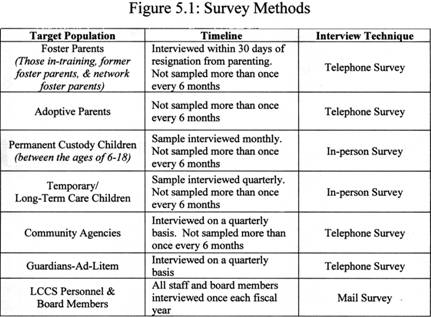Research-Based Continuous Improvement Information Process:
The second part of the overall reengineering process at LCCC was to begin moving LCCS toward a data-driven organization. One critical component of a data-driven organization is assessing satisfaction among internal and external constituents through a variety of survey approaches. The Joint Center for Policy Research (JCPR) in the Public Services Institute was engaged to design and deliver an overall continuous feedback process. Target populations were identified as LCCS personnel, LCCS board members, active clients, closed-case clients (protective and intake), foster parents, adoptive parents, permanent custody children, community agencies, and guardians-ad-litem(GAL).
As with the leadership development component, the research component developed specific design parameters that are important for any agency to consider:
· JCPR would not draw any conclusions about findings nor provide any recommendations. Quarterly and aggregate reports resulting from all of the satisfaction surveys would provide direct information for LCCS.
· JCPR would not use any information gathered for LCCS for any other purpose or research efforts.
· Participants would be randomly selected with absolutely no knowledge or control by LCCS over who would be selected on behalf of LCCS.
· All JCPR interviewers would sign confidentiality agreements and participate in a criminal background check conducted by LCCS.
· The specified number of completed interviews by target population would be dependent upon the number and reliability of listings provided to JCPR by LCCS.
· Where interviewers would hear formal complaints by LCCS clients, clients would be asked if they would like to speak directly with the LCCS ombudsman. Any person desiring to speak to the ombudsman would be forwarded via e-mail to the LCCS Executive Director and in writing to the Ombudsman.
The feedback process includes both active and closed cases. Active cases include clients currently working with the agency and closed cases include those cases within a 30-day time period since “closing.” Active cases are surveyed on a monthly basis and include approximately 10 active cases per month, using both telephone and in-person survey techniques. Important to note is that individuals may not be randomly sampled more than once every four months. For closed cases, approximately 20 clients per month are interviewed via telephone. For any agency engaging in this type of work, the bottom line is to make sure that you are securing a scientific sample of your populations. (Figure 5.1 shows more detail about the populations included and  interviewing frequency.)
interviewing frequency.)
Gathering the data, of course, leads to reporting the data. Quarterly reports are provided to the agency and data are aggregated at 6 month intervals for greater statistical reliability in longitudinal comparisons. In addition, data are aggregated on an annual basis to create a summary of findings. For any agency just starting out in a feedback process, it is critical to understand that being able to see patterns and draw reliable conclusions means on-going collection of data over significant time periods. In other words, this type of data-driven system will require a long-term commitment both of time and resources. However, it insures that decisions will be made based upon reliable information and helps to support two legs of the strategic triangle: value creation and enhancing the authorizing environment.
For those who have provided information through the interviews, it is important to close the feedback loop with them. Through providing reports and having conversations about the data, stakeholders know that their voices are being heard and that the information is meaningful. Consider the following points when thinking through the closing of the feedback loop:
· The framework for closing the feedback loop should include not only “You spoke,” “We listened,” and “Here are some things you said as a group,” but also “This is how the agency is addressing your input.”
· Methods for closing the feedback loop should be considered separately for each target population.
· Approaches to closing the loop should consider invitation to all of the individuals and organizations that have provided feedback.
· When issues are identified, an opportunity should be extended for individuals to participate in a strategy development session so that they become an integral part of the solution.



